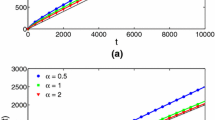Abstract
It is shown that under the central-limit scaling, the fluctuations of the space—time renormalized age distributions of particles (whose development is controlled by critical linear birth and death processes) around the law-of-large-numbers limit converge in a Hilbert space (containing the class of signed Radon measures with finite moment generating functionals) to a continuous Gaussian process satisfying a Langevin equation. So far, the space of rapidly decreasing functions has been considered to be the natural state space for the kind of limit theorem considered here. However, the space of rapidly decreasing functions is not suitable in the present context and we are led to define an appropriate family of Sobolev spaces. In fact, we construct a scale of Hilbert spaces based on the eigenfunctions expansions of an elliptic operator defined on a weightedL 2-space.
Similar content being viewed by others
References
Adams, R. A. (1975). Sobolev Spaces. Academic Press, New York.
Aubin, J. P. (1979). Applied Functional Analysis. Wiley, New York.
Bose, A. (1986a). Age distributions in birth and death processes. In Tautu, P. (ed.), Stochastic Spatial Processes, Lecture Notes in Mathematics, Vol. 1212. Springer-Verlag, New York, pp. 52–58.
Bose, A. (1986b). A law of large numbers for scaled age distributions of linear birth and death processes. Canad. J. Statist., 14:233–244.
Brezis, H. (1983). Analyse Fonctionnelle: Theorie et applications. Masson, Paris.
Ethier, S. N., and Kurtz, T. (1986). Markov Processes: Characterization and Convergence. Wiley, New York.
Holley, R. A., and Stroock, D. W. (1978). Generalized Ornstein—Uhlenbeck processes and infinite particle branching Brownian motions. Publ. Res. Inst. Math. Sci., 14:741–788.
Kallianpur, G., and Wolpert, R. (1984). Infinite dimensional stochastic differential equation models for spatially distributed neurons. Appl. Math. Optim., 12:125–172.
Lions, J. L., and Magenes, E. (1972). Non-Homogeneous Boundary Value Problems and Applications, Vol. I. Springer-Verlag, New York.
Metivier, M. (1987). Weak Convergence of measure-valued processes using Sobolev-imbedding techniques. In Da Prato, G., and Tubaro, L. (eds), Stochastic Partial Differential Equations and Applications, Proceedings, Trento, 1985. Lecture Notes in Mathematics, Vol. 1236. Springer-Verlag. New York, pp. 172–183.
Stroock, D. W., and Varadhan, S. R. S. (1979) Multidimensional Diffusion Processes. Springer-Verlag, New York.
Trèves, F. (1967). Topological Vector Spaces, Distributions and Kernels. Academic Press, New York.
Trèves, F. (1975). Basic Linear Partial Differential Equations. Academic Press, New York.
Uchiyama, K. (1983). A fluctuation problem associated with the Boltzmann equation for a gas of molecules with a cuttoff potential. Japan J. Math., 9:27–53.
Wloka, J. (1987). Partial Differential Equations. Cambridge University Press, New York.
Author information
Authors and Affiliations
Additional information
This research was partially supported by an NSERC of Canada grant.
Rights and permissions
About this article
Cite this article
Bose, A. A fluctuations limit for scaled age distributions and weighted Sobolev spaces. Appl Math Optim 23, 77–105 (1991). https://doi.org/10.1007/BF01442393
Accepted:
Issue Date:
DOI: https://doi.org/10.1007/BF01442393




